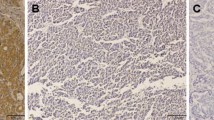Abstract
Purpose: To elucidate the relationship between angiogenesis and prognosis after curative resection of hepatocellular carcinoma (HCC). Methods: An immunohistochemical study using anti-CD34 monoclonal antibody was carried out on surgical specimens from 78 HCC patients who had undergone curative resection; microvessel density (MVD) was counted and the overall survival and disease-free survival were analyzed retrospectively. Results: Blood vessels in the tumor were strongly stained by anti-CD34 antibody, but not those in the surrounding liver parenchyma. There were three types of tumor vessels: capillary-like (n = 59), sinusoid-like (n = 16) and mixed-type (n = 3). The median MVD count was 100 per field. The HCC were designated as hypovascular (n = 36) with an MVD count below 100, and hypervascular (n = 42) with an MVD count of 100 or more per field. The 5-year survival and disease-free survival rates were 49.7% and 42.8% respectively, and statistical analysis showed that the MVD level was not correlated with tumor size, capsule status, Edmondson's grade, α-fetoprotein level, associated cirrhosis, γ-glutamyltransferase, and serum HBsAg status. The sinusoid-like tumor vessels appeared more frequently in the more differentiated tumors (P < 0.05). No statistical difference in overall and disease-free survival between different MVD levels and microvessel types was found. Tumor size was the only predicting factor in the entire series. In patients with small HCC (≤ 5 cm, n = 40), 5-year survival and disease-free survival rates were 58.9% and 52.7% respectively, higher than the values in large HCC (39.8% and 32.0% respectively, P < 0.05). The MVD level was an independent predicting factor of disease-free survival, 5-year disease-free survival in the hypovascular group (74.6%) being better than that in the hypervascular group (34.7%, P < 0.05). Conclusions: The MVD level was not related to tumor size, capsule statuo, Edmondson's grade, α-fetoprotein level, associated cirrhosis, γ-glutamyltransferase and serum HBsAg status. In the entire series, tumor size was the only factor influencing survival after curative resection. However, in patients with small HCC, the MVD level was an independent factor of disease-free survival. The pathological and clinical implications of different types of tumor vessels in HCC remain to be studied.
Similar content being viewed by others
Author information
Authors and Affiliations
Additional information
Received: 27 November 1998 / Accepted: 5 January 1999
Rights and permissions
About this article
Cite this article
Sun, HC., Tang, ZY., Li, XM. et al. Microvessel density of hepatocellular carcinoma: its relationship with prognosis. J Cancer Res Clin Oncol 125, 419–426 (1999). https://doi.org/10.1007/s004320050296
Issue Date:
DOI: https://doi.org/10.1007/s004320050296




